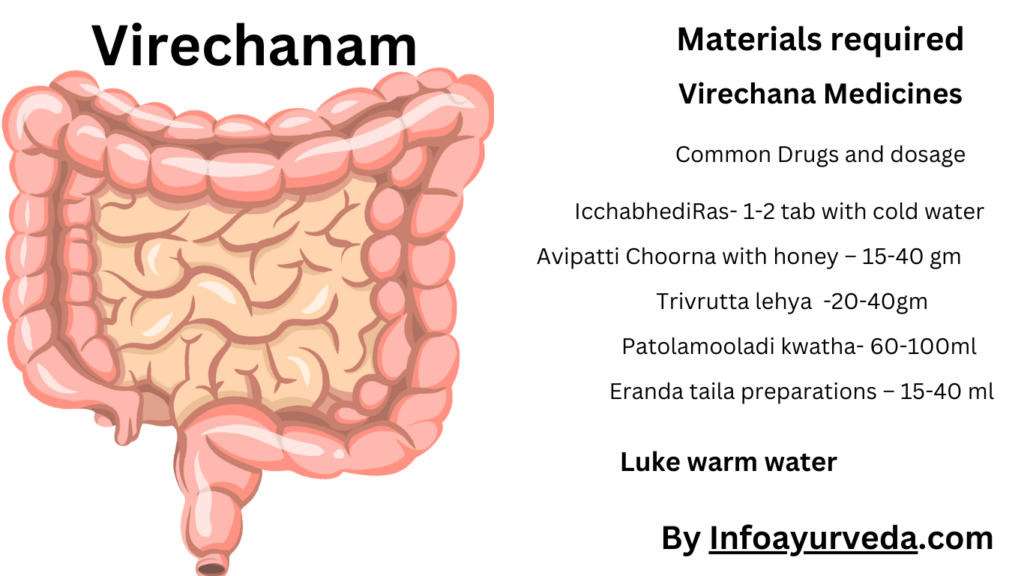Virechana/ Therapeutic Purgation
- Virechana, a key Panchakarma procedure in Ayurveda, is a therapeutic cleansing process designed to eliminate excess Pitta dosha and accumulated toxins from the body. This unique detoxification method holds a distinct place in the holistic approach of Ayurvedic medicine, aiming to restore balance and promote overall well-being.
Virechana is a procedure in which the prakupita doshas are expelled through gudamarga by the administration of medicines through oral route. Medicines are used in different forms like choorna, kwatha, sneha, lehya etc, depending on the condition of the patient.
Procedure Of Virechanam
Preparation Phase: Before undergoing Virechana, individual undergoes a preparatory phase called Snehapana, involving a specific diet and lifestyle regimen. This prepares the body for the elimination of toxins during the main Virechana process.
Selection of Virechanam Medicine: Ayurvedic practitioners carefully select purgative herbs and formulations based on the individual’s constitution and the specific doshic imbalance. These substances are administered in precise doses to induce controlled purgation.
Administration: The individual takes the prescribed herbal formulations, which may include powders, tablets, or liquids. The dosage and combination are tailored to the person’s unique constitution and health condition.
Purgation Phase: The purgative effect leads to a systematic cleansing of the gastrointestinal tract, allowing the elimination of excess Pitta and accumulated toxins. This process is vital for rebalancing the doshas and addressing various health concerns related to digestion, metabolism, and skin issues.
Post-Treatment Care: After the purgation phase, individuals follow a specific post-Virechana diet and lifestyle plan to support the body’s recovery. This includes easily digestible foods and practices that promote a gradual return to normalcy.

Pre Virechana Regime
- Interanal Snehana (Snehapanam) Should be carried out before Virechanam
- After proper snehanpan attaining samyak snehana internal use of sneha should be stopped and 2-3 days resting period should be there.
- Three Abhyanga(Full Body Oil Massage ) should be done during resting phase of virechanam.
- Food restriction should continue as during snehapan days it should be liquid ,warm and light.
- On the day of Virechana, the following things should be ensured before administering the medicine
- Proper sleep in the previous night
- Proper digestion of previous day’s food
- Proper elimination of natural urges
Time Of Giving Virechana Medicines
For virechana Purpose Medicines should be given in Morning in between 8Am-10Am depending on the persons lifestyles and body’s pitta dosha aggravating conditions. Virechanam medicines should be given just during transition period of Kapha And Pitta Kala
Do's & Dont's Of Virechanam
- Virechana oushadha is administered in empty stomach. if needed virechana drugs can be given in divided doses which should be completely administered in 15 mts.
- Proper anupanas like ushnodaka, madhu, milk, triphala kashaya, patoladi kashaya, draksha rasa, ikshu rasa etc. are used.
- Patient is advised to wash face with cold water and mouth with luke warm water and is advised to smell substances like lemon, cardamom etc to prevent vomiting .
- Patient is advised to take rest in the bed and wait till the urge for defecation occurs.
- The patient should not force or hold the urge and should use warm water for all purposes.
- Whenever he feels thirsty, he should drink little quantity of warm water sip by sip till vegas appear.
- Each vega should be observed keenly and should be informed to the doctor.
- He can take rest, but shouldn’t sleep in between the Vegas.
- Physician should record the vital data of the patient at regular intervals.
- Patient is observed for the samyak Virechana lakshana like
- Initial expulsion of stools followed by Pitta (observed as golden yellow colored viscous fluid with a characteristic bilious odour)and at last Kapha (mucous)
- Lightness of the body
- Subsiding of Vega by itself without causing excessive weakness( even if kaphanta is not seen)
- If the patient doesn’t get any urge for defecation, after the previous Vega for a long time, hot water drink and mild local abdominal fomentation is advised.
- After ensuring jeernoushadhalakshanas, subsiding of Vegas, the patient is advised to take bath in lukewarm water followed by samsarjanakrama.
- Enough quantity of water is to be administered to avoid dehydration
Post Virechanam Regime
Once the urges and vegas Stopped and patient had taken bath he should be put on strict diet as per sodhana, which is called as Samsarjan krama. Duration for Samsarjan Krama depends on Grade of virechana
Benefits-
Dosha Balancing: Virechana primarily targets excess Pitta dosha, but it also helps balance other doshas, particularly when done under the guidance of an experienced Ayurvedic practitioner.
Digestive Health: The procedure enhances digestive fire, improves metabolism, and addresses issues such as indigestion, acidity, and constipation.
Skin Conditions: Virechana is known for its positive effects on skin health, helping to alleviate conditions like acne, eczema, and other inflammatory skin disorders.
Mental Clarity: The detoxification process extends beyond the physical realm, promoting mental clarity, focus, and a sense of lightness.
Complication and management:
- Nausea and vomiting – It may occur at the time of intake of medicine and during the procedure. To avoid the feeling of nausea, the patient is advised to smell lemon.
- Feeble pulse, Giddiness, Collapse.- Sidhamakaradhwajam with honey and betel juice, Drakshadi kashaya, Dhanwantharam gulika can be given in this condition.
- Adhmanam (Heaviness of Abdomen)-Swedana should be done locally at abdominal region.
- No Show – Ushnajalapana( Drinking warm water), Swedana (Hot Fomentation).
- Urticaria – Thrikatu with sitha is given
- Abdominal Pain-Ushnajalapana( Drinking warm water), Swedana (Hot Fomentation).
- Dehydration: tender coconut water should be given.
- Electrolyte imbalance: tender coconut water, chincha pani, lime juice with sugar & salt.
Caution
Virechana should only be administered under the supervision of a qualified Ayurvedic practitioner. The choice of herbs, dosage, and duration should be individualized based on the person’s health status and needs.
This Ayurvedic cleansing method, with its personalized and holistic approach, seeks not only to address existing health issues but also to prevent future imbalances, fostering a state of optimal health and vitality.
Disclaimer
Individuals considering Virechana should consult with a certified Ayurvedic practitioner for a tailored and safe experience.
